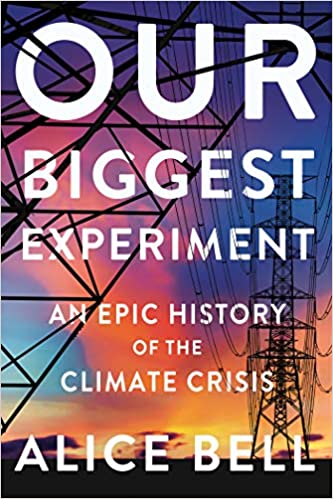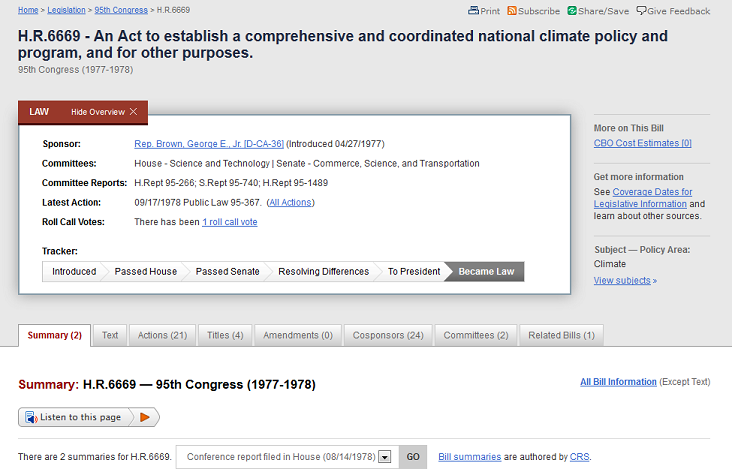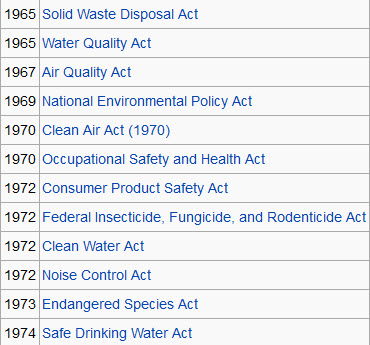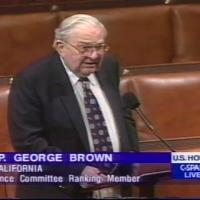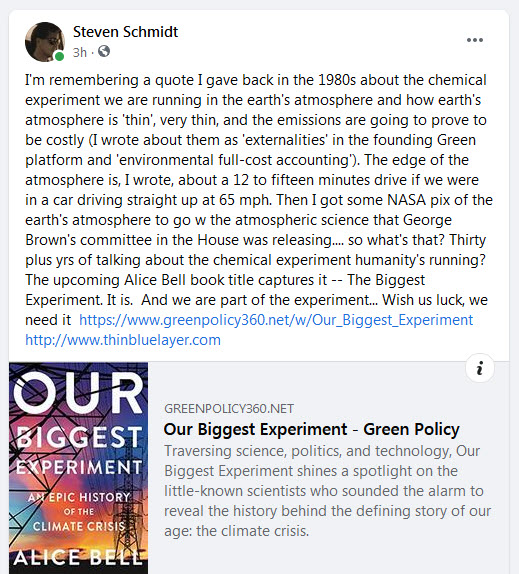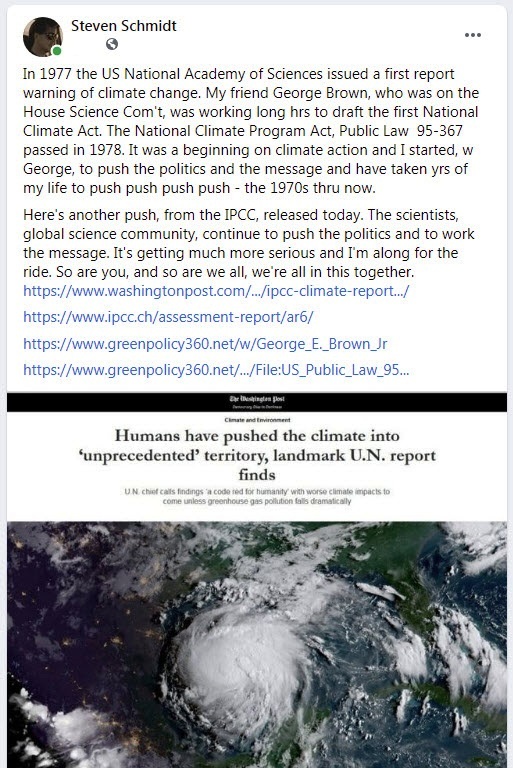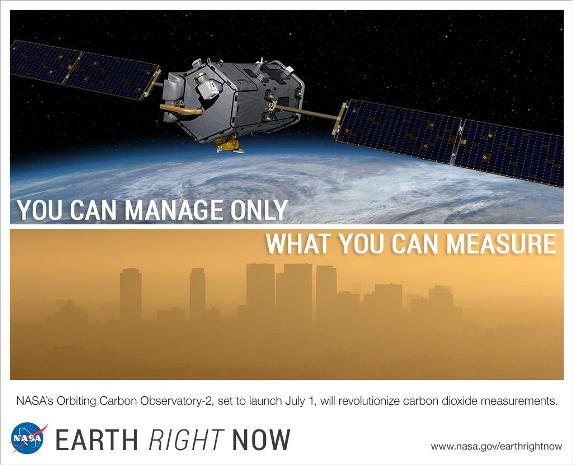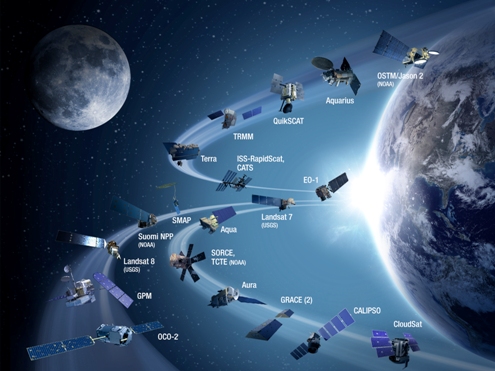Our Biggest Experiment
○ "We are beginning to realize the extent of an existential experiment humanity is conducting in the atmosphere of the planet, the "Thin Blue Layer". The Anthropocene era is a gathering storm that is changing 'nature' as nature used to be... Our challenge is to use our native intelligence to protect the life-enabling atmosphere, to make decisions that sustain and benefit life today and for future generations." -- Steven Schmidt / Green Quotes
GreenPolicy360 Siterunner: The beginnings of modern environmental and climate science can be traced to the 1960s and 1970s. The U.S. National Academy of Sciences played a key role in constructing a scientific foundation of data, research, and reports.... I now look back to memories of the first Climate Act legislation, drafted and shepherded through the U.S. Congress in 1978 by Representative George E. Brown. George Brown was a friend and mentor to your GreenPolicy360 siterunner from the mid-1960s on... George was a visionary, a Chair of the House Science Committee, and a leader in Congress for over three decades, shaping a message pointing to the crucial need for 'Big Science' and environmental protection. Consider how long we have been raising the alarm of out of control climate change.
···································································································
Our Biggest Experiment: An Epic History of the Climate Crisis
- By Alice Bell
Published - September 2021
From the Publisher:
Traversing science, politics, and technology, Our Biggest Experiment shines a spotlight on the little-known scientists who sounded the alarm to reveal the history behind the defining story of our age: the climate crisis.
Our understanding of the Earth's fluctuating environment is an extraordinary story of human perception and scientific endeavor. It also began much earlier than we might think. In Our Biggest Experiment, Alice Bell takes us back to climate change science's earliest steps in the eighteenth and nineteenth centuries, through the point when concern started to rise in the 1950s and right up to today, where the “debate” is over and the world is finally starting to face up to the reality that things are going to get a lot hotter, a lot drier (in some places), and a lot wetter (in others), with catastrophic consequences for most of Earth's biomes.
Our Biggest Experiment recounts how the world became addicted to fossil fuels, how we discovered that electricity could be a savior, and how renewable energy is far from a twentieth-century discovery. Bell cuts through complicated jargon and jumbles of numbers to show how we're getting to grips with what is now the defining issue of our time. The message she relays is ultimately hopeful; harnessing the ingenuity and intelligence that has driven the history of climate change research can result in a more sustainable and bearable future for humanity.
"From histories of energy systems to the development of big science, this comprehensive book is an epic feat of storytelling." –– BuzzFeed
“The story of the climate crisis and the making of the modern world are intertwined, and in this meticulously researched and elegantly written book, Alice Bell is the perfect guide to unpicking how humanity came to face its most profound threat.” — Neil Denny, host of Little Atoms podcast
"Enthralling, compelling, invigorating. Our Biggest Experiment is the story of our ballooning, overwhelming consumption of fossil fuels—it’s about our blundering and dangerous experiment with planetary stability. You might think it’s more important to focus on the future of our planet, but only by understanding our history can we start to shape what happens next. Read this and be energised—on a renewable source of power, of course—to save the world." — Rowan Hooper, host of the New Scientist podcast and author of How to Spend a Trillion Dollars
··································································································
Sixty years of climate change warnings: the signs that were missed (and ignored)
Via The Guardian / By Alice Bell
Pre-pub Our Biggest Experiment: An Epic History of the Climate Crisis by Alice Bell
When Ronald Reagan was elected in November 1980, he appointed lawyer James G. Watt to run the Department of the Interior. Watt had headed a legal firm that fought to open public lands for drilling and mining, and already had a reputation for hating conservation projects, as a matter of policy and of faith. He once famously described environmentalism as “a leftwing cult dedicated to bringing down the type of government I believe in”. The head of the National Coal Association pronounced himself “deliriously happy” at the appointment, and corporate lobbyists started joking: “How much power does it take to stop a million environmentalists? One Watt.”
Watt didn’t close the EPA, as people initially feared he would, but he did appoint Anne Gorsuch, an anti-regulation zealot who cut it by a quarter. Pomerance and his colleagues in the environmental movement were going to be busy. They didn’t exactly have much time for picking up that lingering and still quite abstract problem of climate change. It would still be a while before Pomerance would see a public movement for climate action.
Just before the November 1980 election, the National Academy of Sciences (NAS) had set up a new Carbon Dioxide Assessment Committee to do a follow-up to the Charney report. The chair was Bill Nierenberg, one of the generation of scientists who, like Helmut Landsberg, had been through both the war and the subsequent boom in science funding. He was quite at home working with the government and military. He was even a Jason. He had been a fierce defender of the Vietnam war, which had set him apart from some of his colleagues, and he was still bitter about some of the leftwing protests on campus at the end of the 1960s, and the pushback against military-sponsored science that they had inspired. He also hated the environmentalist movement, which he saw as a band of Luddites, especially on the issue of nuclear power. In many ways, he must have seemed like the perfect person to lead a review that would report back to the new President Reagan.
Nierenberg decided to build his report around a mix of economics and science. In theory, this should have been brilliant. But when it came to publication, the two sides did not cohere. The writers had not worked together, but rather been sent off to be scientists in one corner and economists in another. It has been described as a report of two quite different views – five chapters by scientists that agreed global warming was a major problem, and then two more by economists that focused on the uncertainty that still existed about the physical impacts, especially beyond the year 2000, and even greater uncertainty about how this would play out economically. What’s more, it was the economists’ take on things that got to frame the report, as the first and last chapters, and whose analysis dominated the overall message. Nierenberg seemed to be advocating a wait-and-see approach. There is no particular solution to the problem, he argued at the start of the report, but we can’t avoid it: “We simply must learn to deal more effectively with their twists and turns as they unfold.”
For their 2010 book about climate scepticism, Merchants of Doubt, Naomi Oreskes and Erik Conway dug out the peer-review notes on Nierenberg’s report from the NAS archives. One of the reviews was from Alvin Weinberg, a physicist who had been raising concerns about climate change since the 1970s, and he was less than impressed. In fact, it might be better to say he was appalled by the stance Nierenberg had taken. At one point the report had suggested people would probably adapt, largely by moving. People had migrated because of climate change in the past, it argued, and they would manage again: “It is extraordinary how adaptable people can be,” the report muses.
Weinberg was scathing: “Does the committee really believe the United States or Western Europe or Canada would accept the huge influx of refugees from poor countries that have suffered a drastic shift in rainfall pattern?” Oreskes and Conway did some digging into the reviews and noted that Weinberg’s was not the only negative one (although the others were slightly more polite). Puzzled as to why these criticisms were not responded to, a senior scientist later explained to them: “Academy review was much more lax in those days.”
In the end, the report was launched in October 1983, at a formal gala with cocktails and dinner at the NAS’s cathedral-like Great Hall. Peabody Coal, General Motors and Exxon were all on the invite list – and Pomerance managed to sneak in via the press conference. The White House had briefed the Academy from the get-go, making it clear it did not approve of speculative, alarmist or “wolf-crying” scenarios; that it thought technology would find the answer and it did not expect to do anything other than fund research and see what happened. The NAS knew these people would be in charge for the next few years, and possibly figured that the best idea was to give them the most scientific version they could find of what the White House wanted. Or possibly it simply was what Nierenberg believed. Either way, from the perspective of today, it’s hard not to see it as a big misstep.
The report’s introduction stated up front: “Our stance is conservative: we believe there is reason for caution, not panic.” At the press conference, Roger Revelle, the first scientist to brief Congress on the climate crisis, back in 1957, told reporters they were flashing an amber light, not a red one. And so, the Wall Street Journal reported: “A panel of top scientists has some advice for people worried about the much-publicised warming of the Earth’s climate: you can cope.”
Where were the activists in all of this? Where was that big public movement for action on climate change that campaigners such as Pomerance were longing for? Environmental groups were booming, both in mainstream NGOs and more radical groups, but they tended to focus on other environmental issues...
····························
Response from the GreenPolicy360:
GreenPolicy360 Siterunner: To answer the question 'Where were the activists in all of this?', we were there. We, environmental activists, were working with serious intent and all due diligence to gather the facts to make the global warming case that had to be made. Atmospheric and earth science came to the forefront.
In the 1970s and 80s, and through the 1990s, a key point person in the U.S. Congress was George E. Brown of the House of Representatives Science Committee. George Brown was a leader of the National Academy of Sciences scientific work studying climate. George prepared and authored the legislation that put the scientists studies into action. As a longtime friend, I watched him and assisted him as I could over the years, over decades in his role in the U.S. House of Representatives as a member, then chair of the House Science Committee. George E. Brown was a visionary and led an intensely dedicated and activist effort on the environmental, earth science, and climate front.
His work included authoring the first National Climate Act in 1978. Look closely...
At the Beginning of U.S. Science on Global Warming, Strategies & Planning
Energy and Climate Report, 1977, National Academy of Sciences / 175 pp. / PDF via GreenPolicy360
National Climate Program Act, 1978 / PDF
The first federal program is established to initiate and coordinate federal studies; scientifically assess issues and risks of human-caused climate change, propose action and responses.
1978, the First Climate Act
Congressman Brown, the drafting and passage in 1977 of the First U.S. Federal Climate Report
National Climate Program Act, Public Law 95-367
National Climate Program Act of September 1978
In 1979 came a first follow-on National Science Academy report that was prescient, and accurate, in its global warming predictions.
George Brown and your GreenPolicy360 siterunner first began our friendship in 1965 as the new Congressman joined the Committee on Science & Technology, a role he would have over the next 35 plus years. George's deep green environmental work on the front lines of science inspired your GreenPolicy siterunner. The range and depth, and success, of the environmental programs the Congressman envisioned, initiated, and oversaw was astounding to my young mind.
Begin with his National Climate Act, then go on to see how an array of science was put in place for decades of ongoing programs and action.
Via Wikipedia / https://en.wikipedia.org/wiki/George_Brown_Jr.
Brown was known as a champion for science. He left behind a deep and expansive legacy that has shaped science and science policy in America. Among some of his many accomplishments during his service on the House Science Committee:
• Established the first federal climate change research program in the Federal Climate Program Act of 1978
• Established the Office of Science and Technology Policy
• Established the Environmental Protection Agency
• Established the Office of Technology Assessment
Look at foundation work...
• George Brown on the Omnibus Environmental Bill, 1969
• https://www.greenpolicy360.net/w/Ethics_and_Climate_Change
• @GreenPolicy360, 'The beginning of the modern environmental era'
Look at the record of the 'environmental era'...
Unprecedented environmental protection, a vision that began a process that continues to this day...
Green, environmental public policies, a foundation on which to build sustainable quality of life...
Water quality act
http://www.encyclopedia.com/article-1G2-3456400109/water-quality-act-1965.html
Air quality act http://scholarship.law.duke.edu/cgi/viewcontent.cgi?article=3197&context=lcp
National environmental policy act http://en.wikipedia.org/wiki/National_Environmental_Policy_Act
Clean air act (extended 1970) https://www.gpo.gov/fdsys/pkg/STATUTE-84/pdf/STATUTE-84-Pg1676.pdf
Occupational safety and health act http://en.wikipedia.org/wiki/Occupational_Safety_and_Health_Act
Consumer product safety act http://en.wikipedia.org/wiki/Consumer_Product_Safety_Act
Federal insecticide, fungicide and rodenticide act http://www.epa.gov/agriculture/lfra.html
Clean water act http://en.wikipedia.org/wiki/Clean_Water_Act
Endangered species act http://www.fws.gov/endangered/laws-policies/
Safe drinking water act http://water.epa.gov/lawsregs/guidance/sdwa/basicinformation.cfm
Many of the ideas, policies, values of George E. Brown have carried forward into your GreenPolicy360 siterunner's work. Environmental security and protection. New definitions of national and global security. Climate activism. Planet citizen, planet science activism.
George's work found its way into the presidential campaign of Governor Jerry Brown in 1992, through the campaign's platform that your GreenPolicy siterunner worked on drafting and presenting to the Democratic Party platform committee.
George's work found its way into the founding platform of the new U.S. Green Party, which your GreenPolicy siterunner was a principal drafter.
George's work has found its way into the core science approach and positions of GreenPolicy360 ...
- ···························································
Although the work and role of Congressman Brown rarely is considered, in fact his three decades in Congress produced accomplishments produced the ongoing means to address the climate crisis. His initiatives, from the EPA's establishment to the full range of NASA earth science missions, from the measuring-monitoring-data gathering and study of earth's atmospheric systems, for the first time and across time have delivered data-bases to make the climate action case. George Brown was unparalleled in his atmospheric and earth science record that continues on to this day.
In the U.S. Congress Rayburn building his official portrait looks out over the House Science, Space & Technology hearing room and most ever meeting considering environmental and climate policy decision, the foundation work, the data, the science set in motion by Congressman Brown's effort is up again as the evidence-based science is brought into practice.
Here's to the visionary work of Congressman Brown, from East LA.
Here are a few sites to review, more to come...
The Congressman left us a legacy of vision and action against threats to the atmosphere, earth's life systems, and sustainability.
We have, all who believe in the importance of science, carried forward his thoughts over the years since the 1960s and 1970s. As best we could, we have carried on against deep odds and opposition.
The earth science programs and ongoing constellation of space-based satellite missions that Rep. Brown shepherded continue on, capturing the data and science that George knew had to be gathered to guide intelligent policies on climate and environmental security.
Earth Science Research from Space
New Definitions of National Security
Representative Brown was a first mover in the LANDSAT program .... as well as supporting and extending an encompassing array of NASA 'big science, earth science' missions. He cited the mission of NASA and championed the inter-agency work as critical to national security.
The Original Mission Statement of NASA ((1958) provided Congressional intent and guidance to the first generation of space programs. George, if he were here, would've done I am certain everything within his power to protect the original mission statement...
George, as chairman of the House of Representatives Committee on Science, Space, and Technology, over the years until his sudden death in 1999 played a key role in nuclear weapons oversight. As with the National Climate Act he drafted in the 1970s identifying global warming as a serious, even existential threat, his focus on the threat from his first year in office in the early 1960s saw him leading efforts to reduce the nuclear stockpile and reducing the imminent threat of global destruction. The Congressman's work on non-proliferation stands out. George's letter to the head of the Department of Energy in February 1992 remains a testimony to the need for a new "strategic plan" for the Department of Energy (DOE) nuclear weapons labs.
🌎
George's Obituary:
Born: March 6, 1920 - Died: July 15, 1999 (aged 79)
Los Angeles Times, July 17, 1999
George's Memorial Service / C-Span
○
A Conversation with George E. Brown Jr.
- The Congressman Who Loved Science
(NYT) Mr. Brown, 79... was an author of legislation creating the Environmental Protection Agency, a prime mover behind efforts to include ozone layer protections in the Clean Air Act...
"From my earliest days, I was fascinated by science," Mr. Brown said in his offices on Capitol Hill, his wife, Marta, at his side. "Also by my earliest days, I was fascinated by a utopian vision of what the world could be like.
"I've thought that science could be the basis for a better world, and that's what I've been trying to do all these years.... science -- research and development -- is probably the most important factor in the progress of the human race over the last several thousand years."
- About Us
- Air Quality
- Air Pollution
- Agriculture
- Alternative Agriculture
- Antarctica
- Anthropocene
- Arctic
- Atmospheric Science
- Citizen Science
- City Governments
- Climate Change
- Climate Migration
- Climate Policy
- County Governments
- Desertification
- Digital Citizen
- Earth Imaging
- Earth Observations
- Earth360
- Earth Science
- Earth Science from Space
- Earth System Science
- Ecology Studies
- Eco-nomics
- Economic Justice
- Education
- Energy
- Environmental Laws
- Environmental Protection
- Environmental Security
- Environmental Security, National Security
- ESA
- European Union
- Externalities
- Extinction
- Florida
- Food
- Forests
- Fossil Fuels
- Greenland
- Global Security
- Global Warming
- Green Networking
- Green Best Practices
- Green Politics
- Health
- INDC
- Maps
- Money in Politics
- NASA
- NOAA
- Natural Resources
- Networking
- New Definitions of National Security
- New Economy
- New Space
- Oceans
- Ocean Science
- Online Education
- Planet Citizen
- Planet Citizens
- Planet Citizens, Planet Scientists
- Rainforest
- Renewable Energy
- Resilience
- Sea-level Rise
- Sea-Level Rise & Mitigation
- Seventh Generation Sustainability
- Social Justice
- Soil
- Solar Energy
- Strategic Demands
- Sustainability Policies
- Threat Multiplier
- United Nations
- US
- US Environmental Protection Agency
- Water Quality
- Whole Earth
- Wind Energy
- World Bank
- World Wide Web
- Youth
